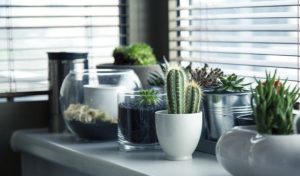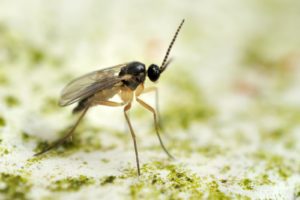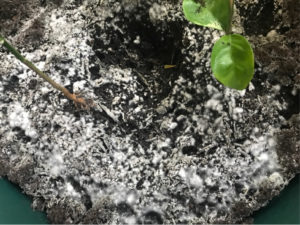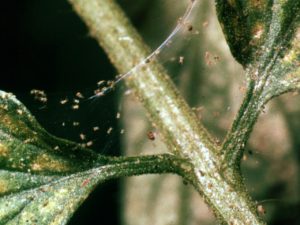
If you are a lover of houseplants, with an ever-growing collection, chances are you’ve encountered contaminated potting soil. It is not only annoying to deal with, it can seriously harm even the most robust leafy beauties. Types of contamination can vary from bugs to harmful microbes, all requiring differing remediation techniques.
 How Does Potting Soil Become Microbially Contaminated?
How Does Potting Soil Become Microbially Contaminated?Potting soil contains a combination of organic, such as steer manure and composted vegetation, and inorganic material, such as rocks and sand. This mixture is often composted at warmer temperatures with a considerable amount of moisture, breaking down the material quicker for the sake of fast production. This creates the perfect environment for bad microbes and fungus to grow. Any time you have a small portion of microbes, given the perfect conditions they can multiply at an extremely high rate.
Common strains of harmful microbes found in potting soil are norcardia, legionella, and clostridium simply as a result of the components. What initially would have been a small population of these harmful microbes, has been given the perfect conditions to grow and thrive during warm composting. High levels of legionella exposure can cause Legionnaires disease, which is a form of atypical pneumonia and symptoms include high fever, muscle pain, shortness of breath, and headaches.
Common strains of harmful microbes found in potting soil are norcardia, legionella, and clostridium simply as a result of the components. What initially would have been a small population of these harmful microbes, has been given the… Share on X How Does Potting Soil Become Contaminated With Bugs?
How Does Potting Soil Become Contaminated With Bugs?Bug eggs and larvae are extremely small, they would be absolutely impossible to see in a bag or container of potting soil. The eggs get mixed into potting soil either by contaminated tools or organic matter. From there the bugs finish their hatching cycle and appear, almost out of thin air, buzzing around your living room.
Getting rid of bugs in your soil and plants is extremely important. As the larvae hatch they feed on small roots and any fungus present in the plant biome, which can cause irreparable damage to your plants. They also tend to have a very small life cycle, meaning they quickly and continually recontaminate the soil by laying more eggs. They also can easily infect all of the plants in your home that are growing in soil by laying their eggs.
Getting rid of bugs in your soil and plants is extremely important. As the larvae hatch they feed on small roots and any fungus present in the plant biome, which can cause irreparable damage to your plants. Share on XIf you’re struggling with any of these issues it can seem like there is no end in sight. With patience and perseverance, you can overcome serious soil contamination without reaching for toxic pesticides, getting rid of, or damaging your plants. Here’s what we recommend:
 Fungus Gnats
Fungus GnatsAn extremely common pest found in mass-produced soils. They are very small black flies, their larvae are impossible to see in the soil. Multiply quickly and can contaminate all plants in the home. Chances are if you have a significant amount of indoor plants it will be more difficult to get rid of fungus gnats because you will have to treat all plants.
WHAT TO DO
 Mold
MoldMuch like your home microbiome, mold is an indicator that the delicate balance of microorganisms in your potting soil is off. The soil you’re using lacks the necessary beneficial bacteria to prevent harmful colonies from thriving. The mold typically found in potting soil appears as white, fuzzy areas on the soil surface. In addition to this being facilitated by over-watering and poor drainage, potting soil can come to you contaminated through improper composting techniques or storage. The best plan of attack is to treat it early on to prevent spreading to other plants/soil.
WHAT TO DO
 Spider Mites
Spider MitesUnfortunately, this pest is extremely contagious to any plants that may be close by AND very difficult to get rid of. They can attack plants both indoors and outdoors, commonly getting into households on plants being brought inside for the winter. Often visible on the undersides of leaves, spider mites act like tiny plant vampires, piercing the leaves to suck out all the fluids. This will eventually kill the plant while the spider mite colony thrives. Most people do not realize they have a spider mite infestation until they see fine webbing all over their plant, at which point the population of mites is quite large.
WHAT TO DO
https://www.cdc.gov/legionella/about/index.html
https://getbusygardening.com/neem-oil-as-organic-pest-control/

Gillian is a former nurse and joined the Homebiotic team as a researcher & science writer. She loves traveling the world and currently lives in Colombia.